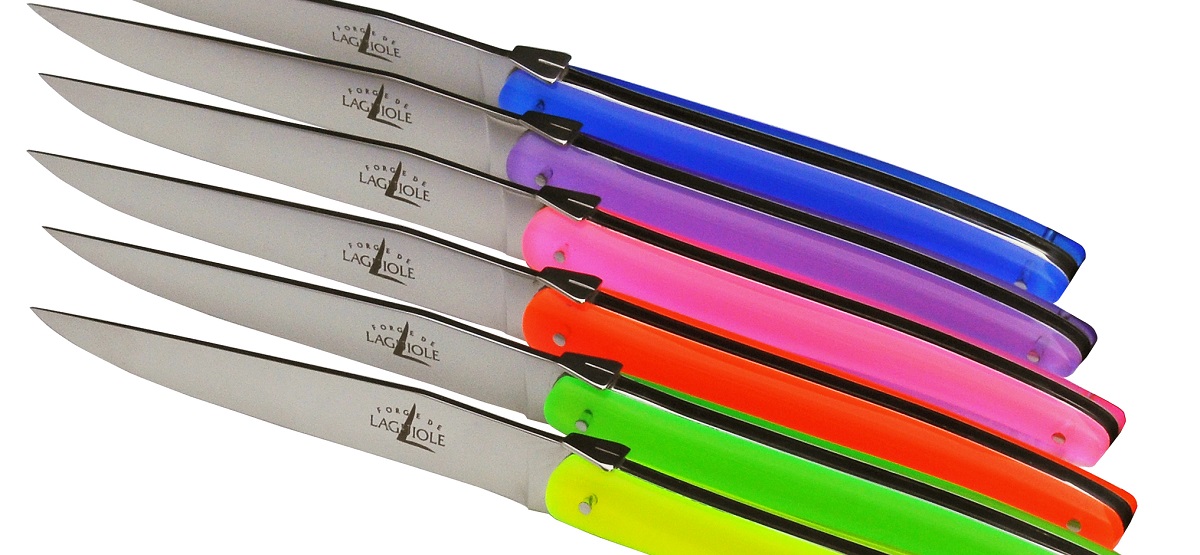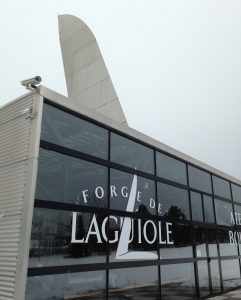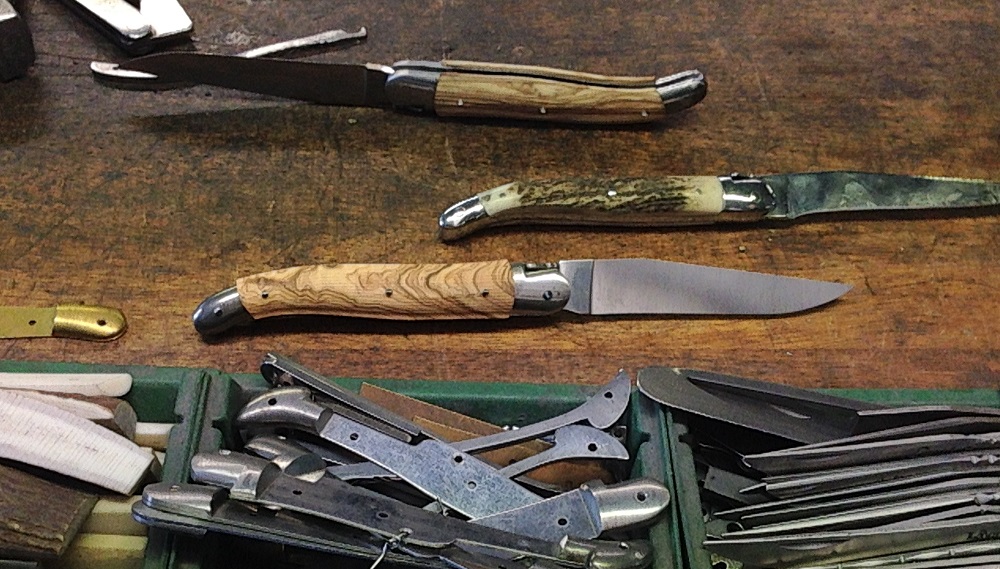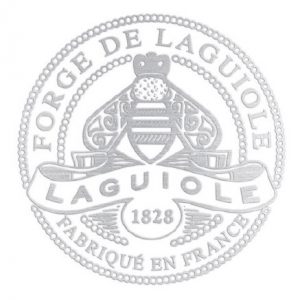
Corinne LaBalme ventures into Deep France to explore the cutting edge of cutlery in Laguiole.
For most Parisians, the granite plateaus of the Aubrac—a mountainous region of central France famed for the pampered cows and sheep that flourish on its austere, volcanic terrain—is flyover country. Or a source of food.
One need only spend a few days in Paris to encounter some of the food products from the region: Aubrac steak, raw-milk Laguiole cheese and crumbly Roquefort cheese. The finest steel to cut into these gourmet delicacies is forged right next to the remote and isolated pastures from which these products come.
Folklore says that specialized cutlery was first produced in the workshops of the village of Laguiole for cowherds and shepherds in the 12th century. But the modern era of Laguiole cutlery began in 1828 when Casimir-Antoine Moulin set up the town’s first purpose-built workshop. The distinctive “Shepherd’s Cross” design on the handles—so that a knife plunged in the ground could serve as an ad hoc altar—dates from those early days. By the end of the century, the Laguiole knife it was on its way to becoming the Swiss army knife of France, with three distinct parts: a blade, a corkscrew and a trocar, a pointy surgical instrument used to pierce the stomachs of cows and sheep afflicted with deadly bloat. The addition of the corkscrew is attributed to the diaspora of the local unemployed population to Paris, where opportunities in café and restaurant businesses were developing.

The craft tradition all but disappeared in the wake of the First World War. Production was mostly just a memory when in 1985, the mayor of Laguiole sought to revive the industry, along with the help of Aubrac-bred entrepreneurs Gilbert et Jean-Louis Costes (best known for their fashion-forward Paris hotels, restaurants and cafés).
Age-old craftsmanship collides with high design at Forge de Laguiole. The new look of knifedom is embodied by the factory designed by architect Philippe Starck. Postmodern architects Denise Scott-Brown and Robert Venturi divided commercial structures into “decorated sheds” (metal box with a prominent logos) and “ducks” (buildings where the function or product is advertised by its form, e.g. a burger joint that’s shaped like a burger), so with a 20-meter aluminum knife blade sticking out of its roof, the Forge de Laguiole fulfills both criteria.
Visitors enter through the boutique filled with showcases of dazzling steel blades accented by sleek handles fashioned from highly polished olive, juniper, cedar, ash, ebony and pistachio wood; semi-precious stone; compressed fabric, and, remarkably, varnished sand which is, amazingly, dishwasher-proof. Horn from Aubrac cattle is also used. No animals are slaughtered for their horns.

Prices begin over 100€ per knife, which may sound intimidating, but these are handmade items designed to last forever. A single knife may require days of work, and at full capacity, the Forge de Laguiole can only manufacture 200 items a day.
Visitors with tinnitus may be wise to abstain from entering the workshops, where tours and demonstrations are offered in July and August. (The boutique remains open most of the year, so off-season visitors can peek through glass windows opening onto the workshops even when there are no tours.) The hammering, polishing and sanding is so noisy that all employees wear earplugs. As might be expected in any enterprise touched by Costes sense of style, the artisans are issued hyper-chic black uniforms. Those who work in ateliers where shards of steel are flying around are decked out in metallic aprons that practically scream “Paco Rabanne.”

Almost like a feudal guild, the team spirit is tangible at Forge de Laguiole. Some employees prefer to specialize in one aspect of production while others enjoy contributing a panoply of different skills. Like Jedi knights fashioning their own light sabers, all employees, even those in administrative posts, learn to assemble a pocket knife in a rite of passage.
Once you’ve watched the welders, woodworkers and polishers at work, you’ll retreat to the boutique and examine the merchandise with even greater respect. In addition to producing traditional knives and corkscrews with the totemic bumblebee insignia (which local legend associates, apparently erroneously, with Napoleon Bonaparte’s appreciation of the town residents), Forge de Laguiole has enlisted contemporary design icons for unique cutlery. Among them, Jean-Michel Wilmotte designed knives with sleek acrylic resin handles in six fluorescent colors and Andrée Putman styled matte-finish knives with cylindrical, Art Deco-ish ebony or ash handles.

While the three-part Laguiole knife can still be found, there’s less of a call for a trocar, but modern consumers may want a specialized gourmet knife. To satisfy them, La Forge de Laguiole has worked closely with Michelin-starred chefs such as Sebastien Bras, Anne-Sophie Pic, Cyril Lignac and Gérald Passédat on specific products. This has allowed the Forge de Laguiole artisans to solve some of the thornier cutlery conundrums of the 21st century by creating, for example, a knife that can cleanly slice soft goat cheese and another for your millefeuille pastry.
There is no governmental, regional or artisanal certification connected with Laguiole knives, so at present it is perfectly legal to sell a “Laguiole” knife that was fully or partially manufactured overseas. Contrary to popular belief in many collectible sites, that bumblebee over the hinge is not a trademark guarantee. So while there’s currently no such thing as a counterfeit Laguiole, there’s a certain authenticity to have one made in the town of Laguiole.
 The direction of La Forge fashions all parts of its knives on the premises and would like to see a strict regulation for regional production, as would the other Laguiole ateliers in town. Several other thriving ateliers creating both traditional and contemporary cutlery also offer tours.
The direction of La Forge fashions all parts of its knives on the premises and would like to see a strict regulation for regional production, as would the other Laguiole ateliers in town. Several other thriving ateliers creating both traditional and contemporary cutlery also offer tours.
Forge de Laguiole. Route de l’Aubrac, BP 9. 12210 Laguiole. Tel.: 05.65.48.43.34. La Forge de Laguiole also has boutiques in Paris (29 rue Boissy d’Anglas, 8th arr.), Toulouse (24 rue des Arts) and Rodez (3 rue Pénavayer).
Laguiole Tourist Office. Place de la Mairie, 12210 Laguiole. Tel.: 05 65 44 35 94. They also provide information about visiting the surrounding zone of Aubrac.
Food & Lodging
In Laguiole, Sebastian Bras presides over a luxury hotel complex, whose kitchen has fluctuated between two and three Michelin stars ever since his father created the now legendary gargouillou, a salad that resembles a flower arrangement. It’s one of the vegan gourmet musts of France. It may be even harder to procure a table at the family-run, roadside diner Le Relais de la Vitarelle in Montpeyroux, where Laurent Falguier’s short-but-sweet daily menu is almost sure to include tender Aubrac steak, the house charcuterie and creamy, cheese-laced Aligot mashed potatoes. LaBa Hôtel (Laguiole/Buenos Aires), has four cozy bedrooms and a tiny restaurant with a killer wine-list.
To learn about Laguiole cheese, visit the cheerful Jeune Montagne Co Op where it’s made. Marcillac is the local wine, made with the fer servadou (aka mansois) grape varietal. It’s a hearty, spicy red wine that stands up to local rustic fare.
Getting There
If you aren’t already on an exploration of the deep center of France, traveling to Laguiole is a commitment that will entail some mountain driving. The nearest city is Rodez, 33 miles southwest, capital of Aveyron, a department in the Occitania region. Setting out for Rodez from Paris by train would take some grit since it’s nearly a seven-hour ride. If looking to reach Aveyron directly from Paris, consider instead a cheerful airline named Amelia after the pioneering aviator Amelia Earhart, whose plane disappeared somewhere over the South Pacific in 1937, to whisk you to Rodez from Orly Airport in roughly an hour. (Rodez is home to the Soulages Museum, a destination in its own right, dedicated to the work of France’s most celebrated living artist, who turned 100 in December 2019. An article about the museum and the artist will be published soon on France Revisited.)
Alternative starting points for an approach to Laguiole are Toulouse to the southeast, Montpellier to the southwest and Clermont-Ferrand to the north. Laguiole is a 2-3-hour drive from any of those cities, though there is so many rural and small-town discoveries to be made along the way that the drive is more likely to take a few days.
© 2020, Corinne LaBalme for France Revisited.



Hello, I had a quick question. You stated that, “Folklore says that specialized cutlery was first produced in the workshops of the village of Laguiole for cowherds and shepherds in the 12th century.” Where is your source on that, especially saying the 12th century?
There are many myths about Laguiole knives. More than one source with whom I spoke – tourist office, manufacturers – claimed a 12th-century origin, but that would depend on a commonly agreed definition of the knife, which is far from certain. That’s why I referred to it as folklore. As to actual evidence of knife-making, or at least knife-sharpening, the local Aubrac-Laguiole tourist board, among others, mentions that in the 14th century the local lord charged a tax on spinning wheels to hone blades. See:
http://www.aubrac-laguiole.com/en/visits-and-outings/cutlery-makers/history-of-cutlery-making